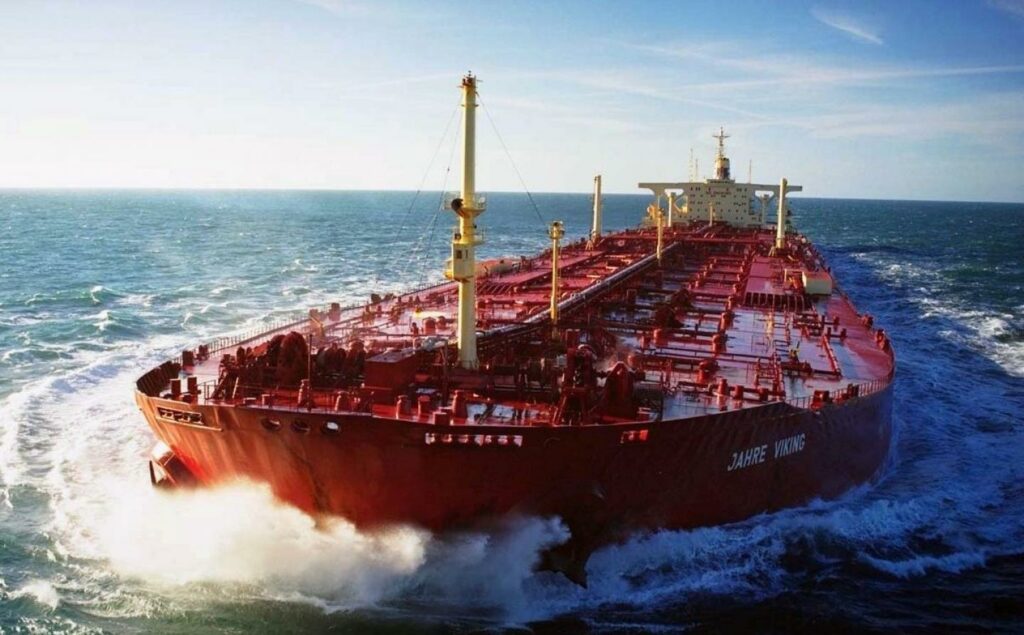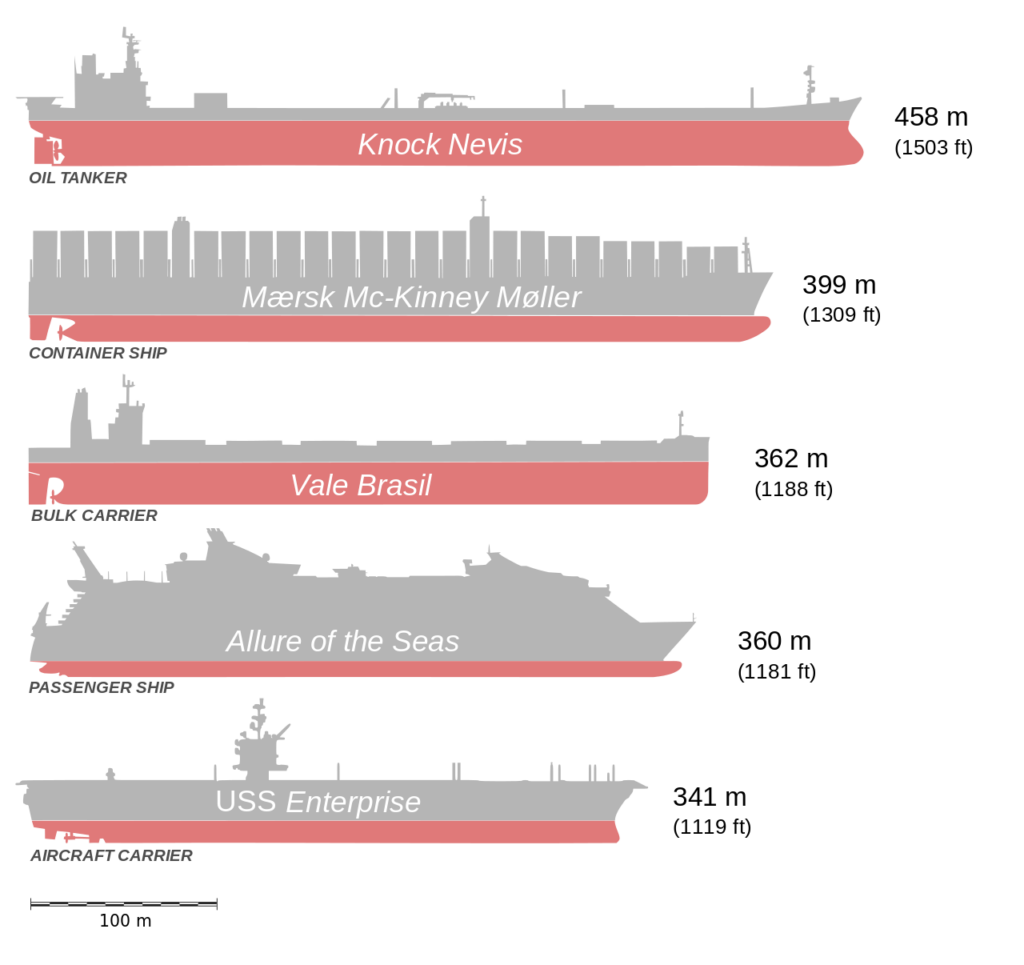In 1979, the Sumitomo Heavy Industries in Japan completed an ultra-large crude carrier (ULCC) that is still the biggest and longest self-propelled ship in history, the Seawise Giant.
Throughout its long and turbulent history, it would be known by several names: Knock Nevis, Oppama, Happy Giant, Jahre Viking, and Mont. It would also pass through several owners, become embroiled in the Iran-Iraq war, be salvaged from its watery grave, and rise again as the tanker Happy Giant.
Before all of this, however, the world’s largest ship resulted from a settlement between its Japanese builders and the Greek company that ordered it.
Bankruptcy made it impossible for the Greek buyer to purchase the ship. So, there was a long arbitration process that allowed Sumitomo to sell the then-unnamed ship to a new buyer: the Hong Kong-based Orient Overseas Container Line.

The Seawise Giant Takes to Sea
Named after a play on the owner’s name, C.Y. Tung, the Seawise Giant then underwent jumboization. This is the process of lengthening a ship by adding another section in the middle.
After two years, the final length of the ship was 1,504.1 ft. It was twice the length of the Titanic and nearly as tall as the Petronas Towers. It had 46 tanks that could carry 4 million barrels of crude oil, two propellers, a deck space of 339,500 sq. ft., and a displacement of 646,000 tons.
When the ship was fully loaded, its draft totaled 80 feet which was too deep to maneuver in certain areas such as the English Channel. It was also too long to travel through the Panama and Suez Canals.

So, despite its impressive and record-breaking size, the Seawise Giant had its weaknesses. The ship traveled at 16 knots or 30 kph. It took 9 kilometers to stop the ship at its normal speed and needed a clearing of 3 kilometers to turn.
At sea, it needed constant monitoring as it negotiated straits and rocky waters. The transfer of cargo was also risky since the ship often operated in the open sea and not in a safe harbor due to its size.
Everything about it was massive — from its rudder and propellers to its gigantic 36-ton anchor. But it was not built for speed, maneuverability, or even longevity.
Embroiled in War
From 1979 to 1988, the Seawise Giant delivered oil from the Middle East to the United States. But then the Iran-Iraq War happened, which played a role in the ship’s fate.
On May 14, 1988, the Seawise Giant was anchored off Larak Island in the Strait of Hormuz on the coast of Iran.
It was one of five oil tankers in the area that was in the middle of transferring and loading oil. Iraqi planes started attacking the oil platform, and all nearby ships were in danger of being hit by parachute bombs.
The Seawise Giant’s size made it an easy target. Before long, it burst into flames and sank into the shallow waters off the coast.
Another tanker, the Barcelona Supertanker, also sank, while three others were damaged but remained afloat.
To this day, the Seawise Giant remains the largest ship that ever sank.
A Shipwreck Waiting To Be Rebuilt
For a few months, the Seawise Giant’s wreck was considered the largest wreck in the world. But given its size, it was only a matter of time before another shipping company would try to rebuild it.
Once the Iran-Iraq War was over, another company bought the wreck.
Norman International salvaged the ship and towed it to a shipyard in Singapore. In 1991, the ship entered service once more as the Happy Giant.
That same year, Norwegian shipowner Jørgen Jahre bought the ship and gave it a new name: Jahre Viking. The ship continued to navigate the oceans under the Norwegian flag from 1991 to 2004.
The Seawise Giant’s Last Days
In 2004, the ship was sold to First Olsen Tankers and renamed Knock Nevis once again. However, it became a permanently moored tanker in the Persian Gulf as the sheer size of the ship meant it operated at a loss.
The Knock Nevis was moored in Qatar’s Al Shaheen Oil Fields until 2009, when it was sold again to Ambers Development. Renamed Mont, it flew the Sierra Leone flag and took its final trip to India.
It arrived in Port Alang in December 2009, the largest ship dismantling area in the world. Most of the world’s vessels are beached and scrapped there, including the ship formerly known as the Seawise Giant.
The Legacy of the Giant
Even in its final days, the Seawise Giant broke a few more records. Often, ship dismantling can take a few months, but due to the sheer size of the vessel, it took a whole year and 18,000 workers to scrap the ship.
You would think that the ship’s record-breaking size would make it exempt from its final fate, but it was not meant to be.
The ship cost more to operate than it could earn as a shipping vessel. So, the decision to scrap the ship was a tragic yet unsurprising eventuality.
The Seawise Giant’s legacy is a mixture of marvels and mistakes. For all its record-breaking feats, its sheer size was more of a burden than a blessing. Though it remains a marvel of shipbuilding and engineering, no ship has ever tried to surpass the Seawise Giant.
Its size limited its speed, flexibility, and movement. Despite its cargo capacity, it also cost more to operate the ship, given the fuel requirements for such a massive vessel.
So, what remains of the Seawise Giant? The name is still found in history books, but only a few remember it. However, if you travel to Hong Kong, you will find the only physical remains of the ship that came back from Port Alang.
On Stonecutters Island, you can find its massive anchor in front of the Hong Kong Government Dockyard Building. The owners still recognize the value and legacy of the ship and donated the anchor to the Hong Kong Maritime Museum.
It is now the only reminder of a Giant who once navigated the seas in peace and war.
Sources
https://www.vesseltracking.net/article/seawise-giant
https://www.nytimes.com/1988/05/15/world/iraq-hits-5-ships-in-persian-gulf.html
http://www.largestshipintheworld.com/largest_ships_in_the_world/knock_nevis_seawise_giant_h.php

